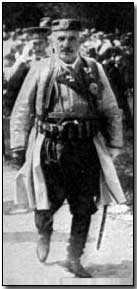Feature Articles - The Minor Powers During World War One - Montenegro
 Montenegro, now part of a shrunken Yugoslavia (along with Serbia) was, in
1914, a small independent kingdom with close ties to Serbia. When
Austria
declared war on Serbia on the 28th July 1914, Montenegro joined her
neighbour shortly afterwards. Montenegro declared war on Austria on
the 7th August and Germany on the 9th.
Montenegro, now part of a shrunken Yugoslavia (along with Serbia) was, in
1914, a small independent kingdom with close ties to Serbia. When
Austria
declared war on Serbia on the 28th July 1914, Montenegro joined her
neighbour shortly afterwards. Montenegro declared war on Austria on
the 7th August and Germany on the 9th.
Austria sent a small force to Montenegro during her offensive against Serbia in October 1915. Serbia was defeated, and many Serbs fled to the Greek island of Corfu.
On the morning of the 8th of January 1916, a 500-gun barrage heralded the opening of the final offensive against Montenegro. 45,000 Austrian troops, alongside 5,000 Bosnian Muslims and 3,000 ethnic Italians serving in the Austro-Hungarian army, attacked Montenegro, and within 48 hours the Montenegrin forces had been driven from their fortress at Mount Lovcen, the "Adriatic Gibraltar".
The capital, Cetinje, fell on the 11th January, and Montenegro surrendered six days later. With no allies left in the Balkans, little Montenegro was doomed.
Those soldiers that managed to escape joined the remnants of the Serb army on Corfu to wait for the day they would retake their home.
Ethnic Montenegrins also served in the Austro-Hungarian army, but were stationed on the Russian front rather than risk setting them against their fellow-countrymen.
In September 1918, Montenegrin soldiers formed part of a "Yugoslav Division" fighting with the allies on the Salonika Front. This predated the creation of a Yugoslav state and shows the determination on the part of the Serbs, Croats, Slovenes, Montenegrins, Bosnians, Macedonians and others to win self-determination from Austria.
Altogether, about 3,000 Montenegrin soldiers died in the Great War.
The "Red Baron" was the allied nickname for German air ace Manfred von Richthofen, the leading ace of the war.
- Did you know?
